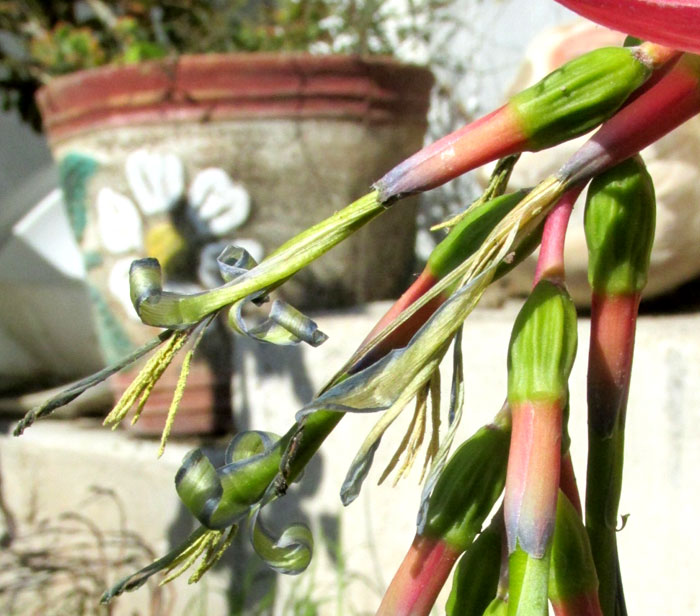Excerpts from Jim Conrad's
Naturalist Newsletter

entry dated December 12, 2022, issued from near Tequisquiapan, elevation about 1,900m (6200 ft), Querétaro state, MÉXICO
QUEEN'S TEARS
In a small village the above bromeliad had been bought from a local dealer in ornamental plants, who comes through once a week to set out his offerings at the small tianguis, which is something like a community garage sale held each Saturday. The above plant is suffering from sunburn, apparently having been grown in shade, then abruptly planted in full sunlight. Also, in Nature this species occurs mostly as an epiphyte growing on tree limbs, though most gardeners seem to grow it in pots, especially those hanging on walls. The above plant's flowering head emerged and fell over into the grass, so the owner tied it onto the stake, to keep ants and snails from eating the flowers. In Nature, the flowering heads dangle below the limb the plant occupies, enabling wind passing below the limb to disperse the seeds. Note that in the center of each plant there's an opening where rainwater gathers. Also, blade margins bear short, sharp, close-together teeth that can saw into delicate skin.

Above, the greenish flowers at the left are less attention-getting than the large, red bracts on the right, attached to the peduncle. However, up close, individual flowers display a pleasing combination of hues:

This is BILLBERGIA NUTANS, often referred to as Queen's-tears, the common name based on the fact that sometimes when the flowers are jarred nectar "weeps" from them. The plant also is known as the Friendship Plant, because mature plants produce offsets which easily can be removed and shared with friends. The species is native to Brazil, Paraguay, Uruguay and Argentina, where it grows on tree branches in rainforests.
At least one website describes Queen's-tears as the most popular of all bromeliads, apparently not only because they are attractive but also easy to propagate and grow. The species has limited roots, adapted mostly to anchoring the plant to its stem, so the plant absorbs most of its moisture from the air, through its leaves and flowers. It's advised to keep the hole in the plant's middle filled with water.